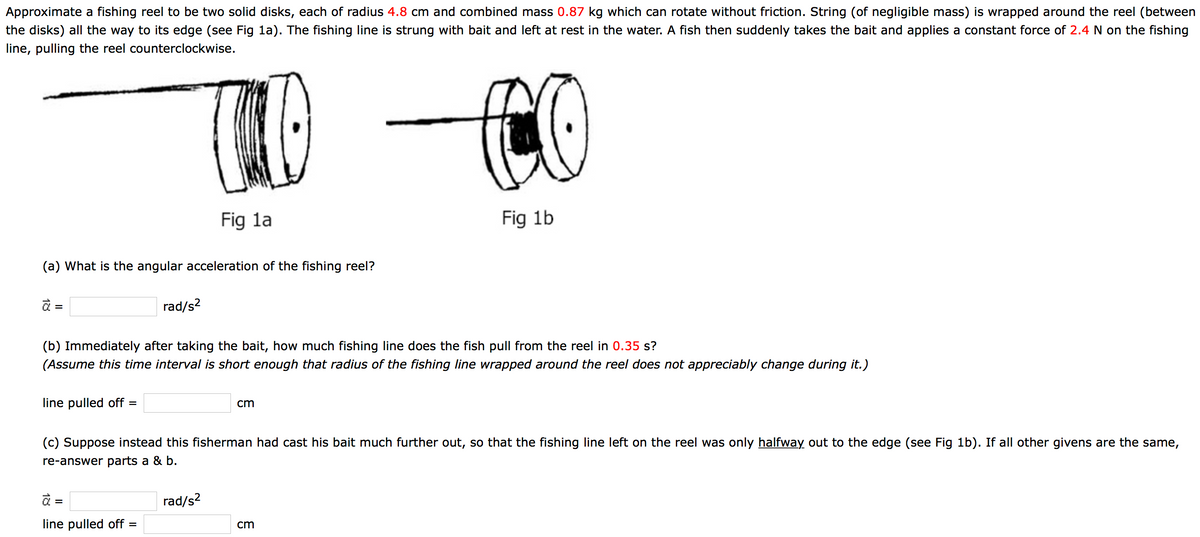A 2 kg mass and a 6 kg mass are attached to either end of a 3 m long massless rod. a.) Find the center of mass of the system. m, from the 2 kg mass. Find the rotational inertia (I) of the system when rotated about: b.) the end with the 2 kg mass. kg m2 c.) the end with the 6 kg mass. kg m2
A 2 kg mass and a 6 kg mass are attached to either end of a 3 m long massless rod. a.) Find the center of mass of the system. m, from the 2 kg mass. Find the rotational inertia (I) of the system when rotated about: b.) the end with the 2 kg mass. kg m2 c.) the end with the 6 kg mass. kg m2
University Physics Volume 1
18th Edition
ISBN:9781938168277
Author:William Moebs, Samuel J. Ling, Jeff Sanny
Publisher:William Moebs, Samuel J. Ling, Jeff Sanny
Chapter11: Angular Momentum
Section: Chapter Questions
Problem 59P: A bug of mass 0.020 kg is at rest on the edge of a solid cylindrical disk (M=0.10kg,R=0.10m)...
Related questions
Question

Transcribed Image Text:A 2 kg mass and a 6 kg mass are attached to either end of a 3 m long massless rod.
a.) Find the center of mass of the system.
m, from the 2 kg mass.
Find the rotational inertia (I) of the system when rotated about:
b.) the end with the 2 kg mass.
kg m2
c.) the end with the 6 kg mass.
kg m2
d.) the center of the rod.
kg m2
e.) the center of mass of the system.
kg m2
(Compare this to parts b-d. Is this what you expect?)
f.) Suppose a frictionless pivot is attached at the center of mass, such that the system is free to rotate about this point in the horizontal plane. A force of 6 N is exerted perpendicular to the rod,
pushing directly on the 6 kg mass. What is the size of the system's angular acceleration that would result?
rad/s?

Transcribed Image Text:Approximate a fishing reel to be two solid disks, each of radius 4.8 cm and combined mass 0.87 kg which can rotate without friction. String (of negligible mass) is wrapped around the reel (between
the disks) all the way to its edge (see Fig 1a). The fishing line is strung with bait and left at rest in the water. A fish then suddenly takes the bait and applies a constant force of 2.4 N on the fishing
line, pulling the reel counterclockwise.
Fig la
Fig 1b
(a) What is the angular acceleration of the fishing reel?
à =
rad/s2
(b) Immediately after taking the bait, how much fishing line does the fish pull from the reel in 0.35 s?
(Assume this time interval is short enough that radius of the fishing line wrapped around the reel does not appreciably change during it.)
line pulled off =
cm
(c) Suppose instead this fisherman had cast his bait much further out, so that the fishing line left on the reel was only halfway out to the edge (see Fig 1b). If all other givens are the same,
re-answer parts a & b.
à =
rad/s?
line pulled off =
cm
Expert Solution
This question has been solved!
Explore an expertly crafted, step-by-step solution for a thorough understanding of key concepts.
This is a popular solution!
Trending now
This is a popular solution!
Step by step
Solved in 4 steps with 3 images

Knowledge Booster
Learn more about
Need a deep-dive on the concept behind this application? Look no further. Learn more about this topic, physics and related others by exploring similar questions and additional content below.Recommended textbooks for you

University Physics Volume 1
Physics
ISBN:
9781938168277
Author:
William Moebs, Samuel J. Ling, Jeff Sanny
Publisher:
OpenStax - Rice University

College Physics
Physics
ISBN:
9781285737027
Author:
Raymond A. Serway, Chris Vuille
Publisher:
Cengage Learning

Glencoe Physics: Principles and Problems, Student…
Physics
ISBN:
9780078807213
Author:
Paul W. Zitzewitz
Publisher:
Glencoe/McGraw-Hill

University Physics Volume 1
Physics
ISBN:
9781938168277
Author:
William Moebs, Samuel J. Ling, Jeff Sanny
Publisher:
OpenStax - Rice University

College Physics
Physics
ISBN:
9781285737027
Author:
Raymond A. Serway, Chris Vuille
Publisher:
Cengage Learning

Glencoe Physics: Principles and Problems, Student…
Physics
ISBN:
9780078807213
Author:
Paul W. Zitzewitz
Publisher:
Glencoe/McGraw-Hill

College Physics
Physics
ISBN:
9781938168000
Author:
Paul Peter Urone, Roger Hinrichs
Publisher:
OpenStax College

College Physics
Physics
ISBN:
9781305952300
Author:
Raymond A. Serway, Chris Vuille
Publisher:
Cengage Learning

Principles of Physics: A Calculus-Based Text
Physics
ISBN:
9781133104261
Author:
Raymond A. Serway, John W. Jewett
Publisher:
Cengage Learning